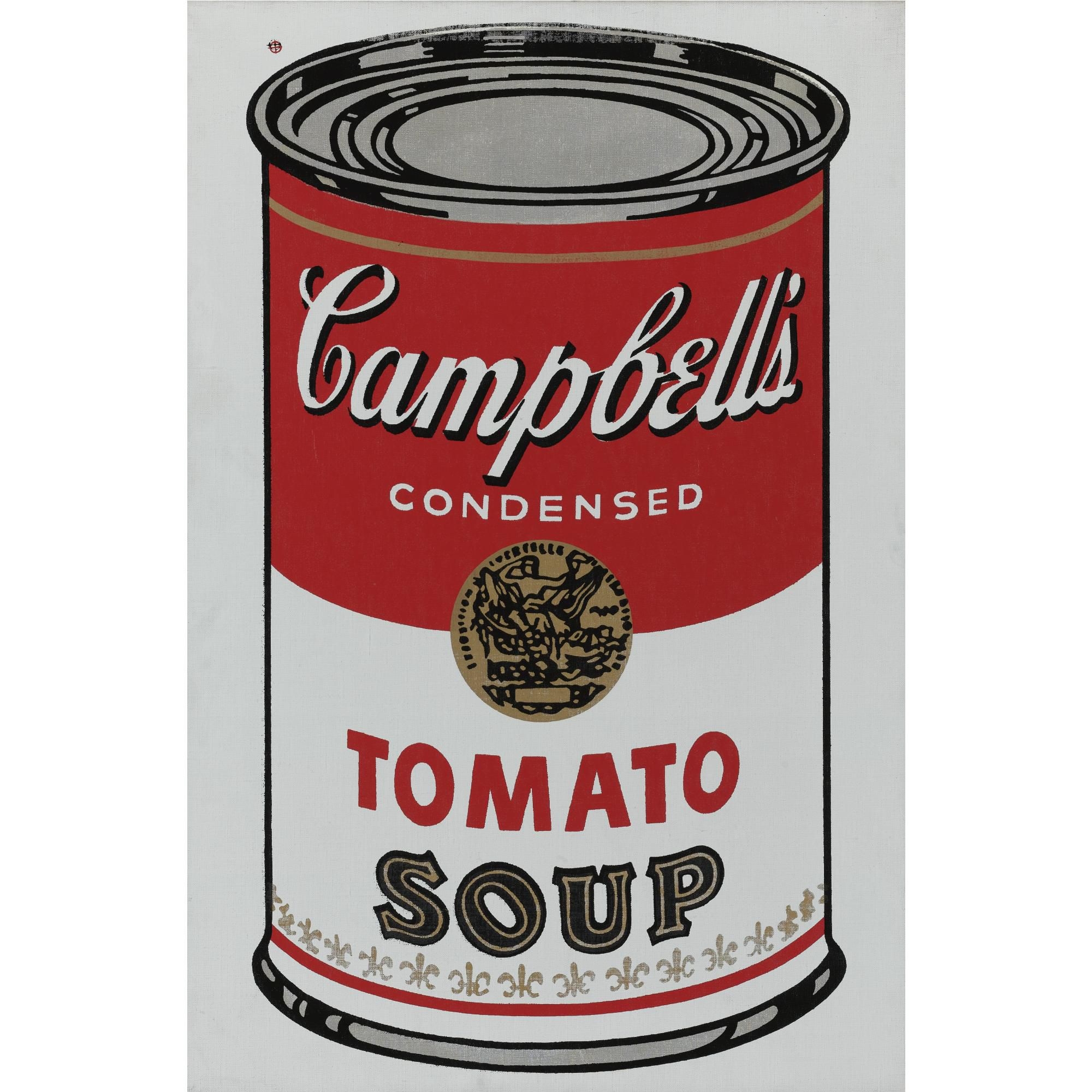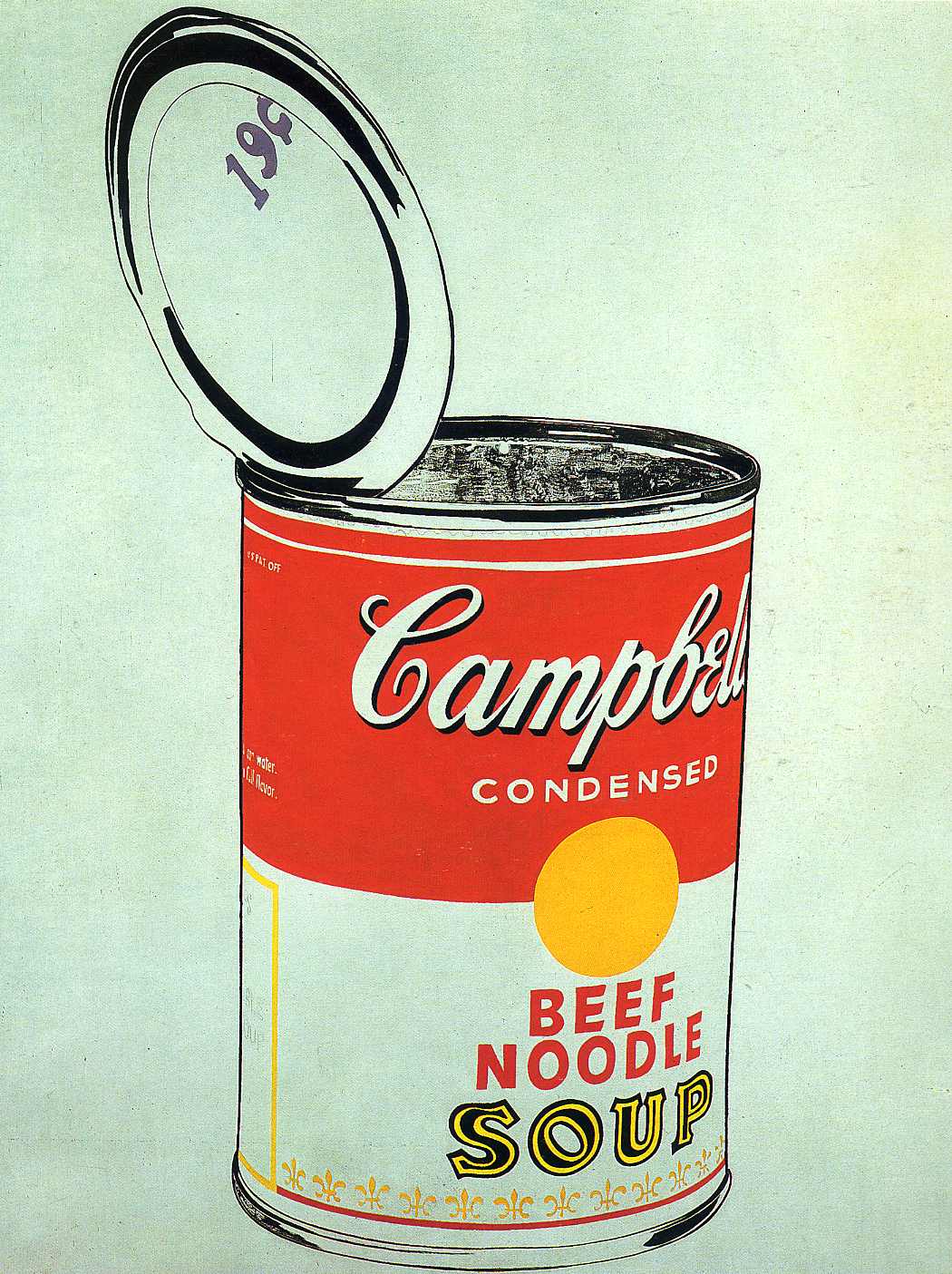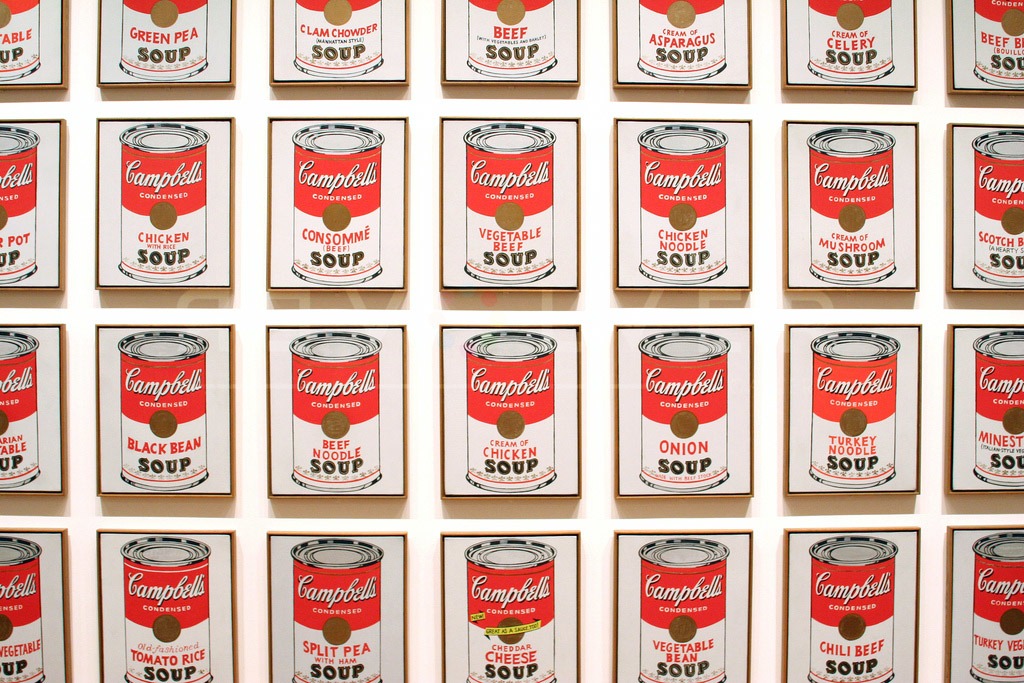
Andy Warhol Campbell Soup Cans Campbell soup, Campbell's soup cans, Soup
New York CNN Business —. Sixty years ago today, the pop artist Andy Warhol unveiled a wall of 32 Campbell Soup can paintings at a Los Angeles gallery, one for each flavor of soup then in.

Andy Warhol Tomato Soup (1962) Campbell's soup cans, Andy warhol soup cans, Andy warhol
The price: $1 and two Campbell's Soup labels. Today, Warhol soup cans remain a pop culture icon, turning up on everything from plates and mugs to neckties, t-shirts, surfboards and skateboard.

The Story of Andy Warhol’s 'Campbell’s Soup Cans' Prints Sotheby’s
Andy Warhol famously appropriated familiar images from consumer culture and mass media, among them celebrity and tabloid news photographs, comic strips, and, in this work, the widely consumed canned soup made by the Campbell's Soup Company.When he first exhibited Campbell's Soup Cans in 1962, the canvases were displayed together on shelves, like products in a grocery aisle.

Andy Warhol Campbell's Soup Cans Why Is This Art
In 1962, he exhibited the now-iconic paintings of Campbell's soup cans. Andy Warhol is also well known for the high values placed on his work, in fact, the artist is among the few who have achieved in excess of $100 million for a work at auction. His 1963 two-panel masterpiece "Silver Car Crash (Double Disaster)" was sold for $105.4.
.jpg)
Andy Warhol (19281987) , Campbell's Soup Can (Tomato) Christie's
Campbell's Soup Cans (sometimes referred to as 32 Campbell's Soup Cans) is a work of art produced between November 1961 and June 1962 by American artist Andy Warhol.It consists of thirty-two canvases, each measuring 20 inches (51 cm) in height × 16 inches (41 cm) in width and each consisting of a painting of a Campbell's Soup can—one of each of the canned soup varieties the company offered.
Art Reproductions Campbell`S Soup Can (tomato) by Andy Warhol (Inspired By) (19281987, United
Exhibition. Apr 25-Oct 18, 2015. Andy Warhol's Campbell's Soup Cans is the signature work in the artist's career and a landmark in MoMA's collection. The 1962 series of 32 paintings is the centerpiece in this focused collection exhibition of Warhol's work during the crucial years between 1953 and 1967. The Soup Cans mark a breakthrough for Warhol, when he began to apply his seminal.

Andy Warhol Warhol paintings, Campbell's soup cans, Warhol art
In 1981, the Colorado State University Department of Art created three giant Campbell's Soup Cans for the opening of the "Warhol at Colorado State University" exhibit. They followed.

Andy Warhol Large Campbell's Soup Can (1964) MutualArt
The Campbell's Soup Cans have since become a sought-after piece of Warhol's work, with a combined gift and sale of the 32 "Ferus Type" cans to the Museum of Modern Art for $15 million, or $468,750 a can. Andy Warhol's Campbell Soup Cans represent his ongoing fascination with consumer culture and are a testament to the artist's.
.jpg)
Andy Warhol (19281987) , Campbell’s Soup Can (Chicken with Rice) Christie's
Andy Warhol. Coca-Cola [3] Marilyn Diptych; Why is this art? Andy Warhol's Campbell's Soup Cans; The Case for Andy Warhol; Gold Marilyn Monroe. Marisol, The Party; Claes Oldenburg. Lipstick (Ascending) on Caterpillar Tracks; Floor Cake. James Rosenquist, F-111; Kay WalkingStick (Cherokee), Me and My Neon Box; Betye Saar, Liberation of Aunt.

Big Campbell's Soup Can 19c (Beef Noodle), 1962 Andy Warhol
Warhol's final breakthrough into '60s Pop came through an accidental inspiration from a minor dealer on the New York scene named Muriel Latow. She was a flamboyant decorator, three years.

Andy Warhol Soup Can Prints Stolen from Museum Revolver Gallery
About the Art. Warhol's Campbell's Soup Can paintings are key works of the 1960s pop art movement, a moment when many artists made work derived from popular culture. Warhol's Campbell's Soup Cans elevate the popular or everyday to the status of art. The Campbell's brand and its red-and-white label date from the late nineteenth century and became increasingly familiar in the twentieth.

Campbell's Soup Can, 1965 (pink & red) Art Print by Andy Warhol King & McGaw
Brenna Miller. In the 50 years since they first went on display, Andy Warhol's 32 Campbell's Soup Cans have become a canonical symbol of American Pop Art. Warhol, an American commercial illustrator from Pittsburgh, Pennsylvania turned fine artist, author, publisher, painter, and film director, first showed the work on July 9, 1962 in the.
.jpg)
Andy Warhol (American, 19281987) , Campbell's Soup Can (Tomato) Christie's
But in the Museum's current exhibition, Andy Warhol: Campbell's Soup Cans and Other Works, 1953-1967, for the first time at MoMA, and only the fourth time anywhere, they are being presented in a single line.Also for this occasion, the outer frames and Plexiglas barriers that usually cover the canvases have been removed, and the works have been propped on ledges.
.jpg)
Andy Warhol (19281987) , Campbell's Soup Can Christie's
Lucien Alexander. 10 years ago. A lot of artists in art history are remembered not just for what they did but simply if they did it first. Warhol did this first. Warhol did this piece in 1962 and used cheap advertising to reflect and question the culture at the time. Coming out of 1950's America this was subversive.
.jpg)
Andy Warhol (19281987) , Campbell's Soup Can (Pepper Pot) Christie's
Andy Warhol's Soup Cans have become synonymous with the Pop art movement, and are responsible for propelling Warhol into a celebrated career in fine art from his day job as a comic illustrator.The motif made its debut in 1962 when Warhol mounted his first solo show featuring 32 canvases painted with Campbell's Soup Cans—one for each flavor the company sold at the time.
Campbell`S Soup Can (beef) by Andy Warhol (19281987, United States) Artwork Replica Andy
Campbell's Soup Cans, which is sometimes referred to as 32 Campbell's Soup Cans, is a work of art produced in 1962 by Andy Warhol.It consists of thirty-two canvases, each measuring 20 inches (51 cm) in height × 16 inches (41 cm) in width and each consisting of a painting of a Campbell's Soup can—one of each of the canned soup varieties the company offered at the time.